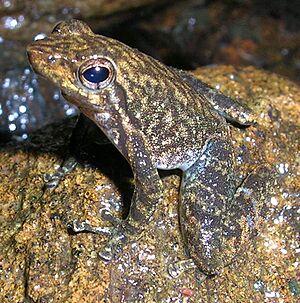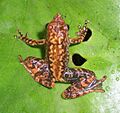Black torrent frog facts for kids
Quick facts for kids Black torrent frog |
|
|---|---|
 |
|
| Conservation status | |
| Scientific classification | |
| Synonyms | |
|
The Micrixalus saxicola, also known as the black torrent frog, is a small frog found in the Western Ghats mountains of India. These frogs live near forest streams. They are known for their brown backs and white undersides. Their smooth skin helps them blend in with their surroundings.
Male black torrent frogs are very protective of their space. They use special calls and movements, like foot tapping, to warn other males to stay away. Sadly, the Micrixalus saxicola is considered a vulnerable species. This means it is at risk because its home is shrinking and being broken up. Human activities and a dangerous fungus also threaten these unique frogs.
Contents
About the Black Torrent Frog
What Does it Look Like?
The Micrixalus saxicola is a small frog. It usually grows to be about 2.5 to 4 centimeters (1 to 1.5 inches) long. Female frogs are a bit bigger than males. Most of these frogs have a brown back. Their belly is white, and their throat and chest are dark brown with white spots.
Their skin is smooth, and their colors help them hide. This is called cryptic coloration. It helps them blend in with rocks when they are resting. They have a pointy snout and oval-shaped nostrils near their eyes. Their hind legs have light gray webbing, but their fingers do not. The tips of their fingers and toes have large, flat discs.
Baby Frogs: Tadpoles
Baby Micrixalus saxicola are called tadpoles. Not much is known about them specifically. However, scientists think they might live partly underground. This is because female frogs lay their eggs in small holes they dig in the sand underwater. Tadpoles of similar frogs are described as "eel-like." They have strong bodies and tails, but their eyes are not well developed when they are very young.
Where Do They Live?
The black torrent frog lives only in the Western Ghats mountain range in India. You can find them in the states of Kerala and Karnataka. They usually live in places that are between 400 and 1400 meters (1,300 to 4,600 feet) above sea level. Even though they are found across the Western Ghats, the groups of frogs are often far apart.
These frogs prefer moist forests, especially near clear, fast-moving streams and rivers. They often rest on rocks along the water's edge. During the dry season, they might hide in leaf litter on the forest floor. They like cooler air, water, and soil temperatures. This usually means they live in areas with thick forest cover. This cover blocks a lot of sunlight from reaching the ground. Studies show they also prefer slightly acidic water and soil. This water usually has a lot of oxygen and not much carbon dioxide.
How Do They Behave?
The Micrixalus saxicola is active during the day. You can often see them clinging to flat rocks in fast-moving streams. During heavy monsoon rains, they might move away from the strong currents. Adult frogs communicate with each other in groups.
Attracting a Mate
Male frogs sit on rocks near streams and waterfalls to attract females. These spots are usually a few centimeters above the water. They mainly attract females by calling. Their call sounds like "Chir… chir… chir… chir… ri… ri… ri… ri ri.." Humans can hear it from up to 14 meters (45 feet) away. Males call about 13 times per minute. They call most often during the breeding season, which is from July to October.
Males call for a few minutes in one direction. Then they turn and call in another direction. Longer calls might attract more females. They also show other males that they are strong and ready to defend their spot. Females do not make any known calls.
The frog's home is often noisy from the environment and other frogs. So, these frogs have developed special ways to communicate. One way is by inflating and deflating their bright white vocal sac. This helps them call faster and makes their sound travel further. The white color also helps other males see where the sound is coming from. This helps them hear each other better over the background noise.
Protecting Their Space
Male Micrixalus saxicola are very territorial. They will defend the rocks where they call. They use calling and foot-tapping to warn other males. Another main behavior is "foot-flagging." This is when a male lifts and stretches one of its back legs away from its body for 20 to 30 seconds.
Foot-flagging is thought to be a way to avoid fights between males. This helps them avoid getting hurt while competing for territory and mates. This is different from some other frogs where foot-flagging is part of courtship. The amount of foot-flagging a frog does is linked to its testosterone levels. Higher testosterone means more frequent and rounder foot-flags.
If calling and foot-flagging do not work, males will try to chase intruders away. They might even kick or jump on other frogs. However, actual fights are rare. Males usually only kick if another frog gets very close. Fights can last from 10 seconds to 2 minutes. Males tend to call and foot-flag more often earlier in the day. This is when defending their territory is most important for mating. Staying on a perch above the water also helps them avoid predators.
How They Reproduce
If another male tries to bother a mating pair, the pair will kick the intruder. They might also move to a new spot. Females dig a small underwater hole, about 2x2x2 centimeters (1x1x1 inch), to lay their eggs. The eggs are about 2.5 millimeters (0.1 inch) wide. A female can lay around 150 eggs at a time. Once the eggs are laid, the parents do not care for them. The tadpoles are left to survive on their own.
Threats to the Black Torrent Frog
The Micrixalus saxicola is listed as a Vulnerable species by the IUCN. This means it is at high risk of becoming endangered. The biggest dangers to these frogs are:
- Loss of habitat: Their forest homes are disappearing.
- Habitat fragmentation: Their homes are being broken into smaller, separate pieces.
- Human interference: People's activities harm their environment.
Local villages sometimes collect leaf litter from the forest. This litter is used to fertilize gardens. But removing it takes away important hiding places for frogs. Tea and rubber farms also pollute the water and soil with waste, pesticides, and chemicals. This is a big threat to the clean streams these frogs need for reproduction. Some smaller streams have even dried up because water is taken for farms or factories. These problems are very serious for the black torrent frog and other amphibians in India.
Another threat is a fungus called Batrachochytrium dendrobatidis (Bd). This fungus causes a disease called chytridiomycosis. This disease has caused many amphibian populations to decline or even disappear. It is a serious concern for the black torrent frog and other rare frogs in the Western Ghats.






